Maine Windjammer Cruises
Sailing the granite-crusted, heavily-forested, 3500-mile (5600-km) coast of Maine, dodging among its hundreds of islands swept along by the wind—a Maine windjammer cruise is among New England's finest outdoor experiences.
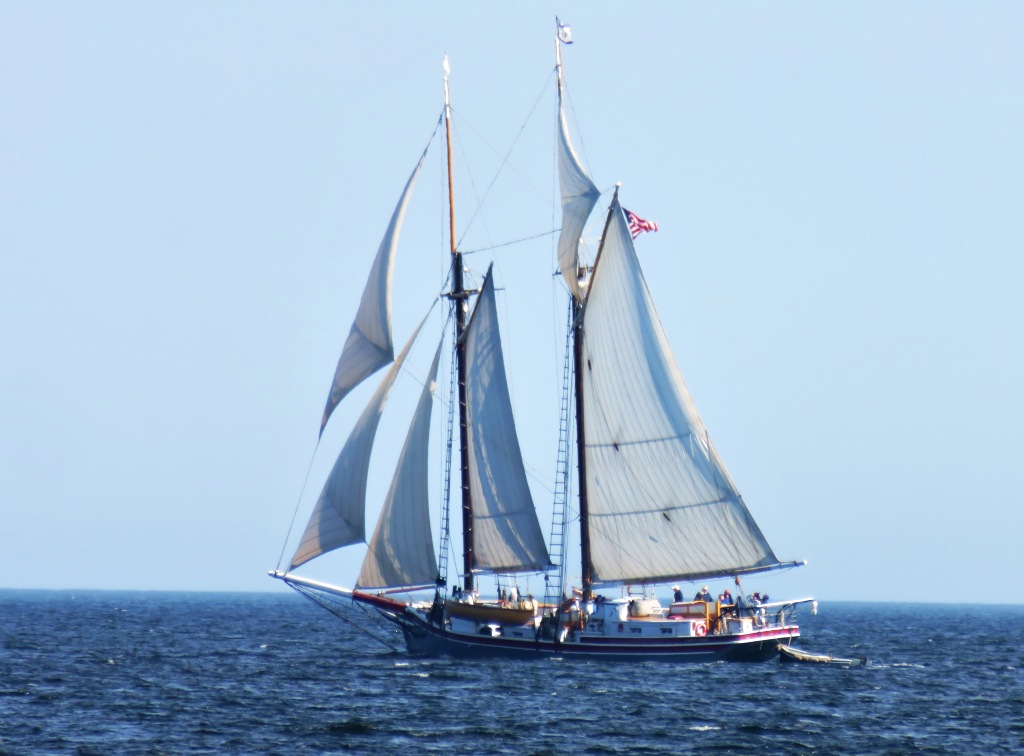
Maine windjammer under full sail—a magnificent sight!
Cruising on a windjammer along the beautiful coast and islands of midcoast Maine may be the quintessential New England experience. If you have the time, you certainly should do it.
Here's all the information you'll need to get started:
What's a Maine Windjammer?
Maine windjammers are sailing vessels of two types:
Sloop or Schooner
A schooner is a sailing vessel rigged fore and aft, with at least two masts, of which the foremast is often smaller.
A sloop is a single-masted sailing vessel rigged fore and aft, with a short standing bowsprit (if it has a bowsprit at all), and a single headsail set from the forestay.
How They Sail
Most Maine windjammers have an auxiliary engine or yawl boat for calm days and/or for maneuvering in port, but the main motive force is by wind and sail. The wind really does move you along, and if there's no wind you go slow, or anchor until the wind rises.
Traditional schooners and sloops in Maine windjammer service are relatively small vessels, not large cruise ships. Space on board is at a premium, and is used with great economy. Accommodations and facilities are not luxurious, but of adequate comfort.

Sail power: it's worked for 3000 years—and still does!
Passengers as Crew
On a traditional Maine windjammer cruise, voyagers may volunteer to help the crew to hoist, lower and furl the sails and other simple tasks requiring many hands. Such work is your choice, of course—no requirement.
That's part of the fun! For many voyagers, the problem is not that they have to share in the crew's duties, but that they always want to do more and really have the experience of being part of the vessel's life.
The most exciting duty is to take the helm and steer the vessel, which may be possible if conditions permit.
Luckily, voyagers never have to help with kitchen clean-up!
Who Can Cruise?
Windjammers are real sailing ships—usually historic sailing ships—built for hearty seamen, so they are ill-adapted to those with mobility challenges. Children are usually welcome if they are age 12 or older.
When to Cruise
The weather along the Maine coast is very changeable and unpredictable: sun, clouds, wind, rain and temperatures may vary substantially from hour to hour, so you must depend on the luck of the draw.
You never really know what the weather will be.
Don't expect weather along the Maine coast to be like weather anywhere else in New England.
It may be cool and foggy on any August morning. It may be warm and toasty in the sun in October (but it will definitely be chilly at night).
In June 2019, I was on a cruise that enjoyed four full days of perfect weather: bright sun, mostly moderate temperatures, mild to moderate winds, but this was exceptional. I did not expect such weather for four full days; and on the fifth day it rained buckets all day.
Best Months to Cruise
July and August are the warmest months for windjammer cruising, but also busiest and most expensive; and you must still pack and be prepared for chilly, rainy, windy days.
June and September can be ideal, given some luck, and cruising in these months is somewhat cheaper than in high summer.
May and October can be adventurous, and are the least expensive times to cruise, but be prepared for any weather.
What to Pack
Unlike big-ship cruises, Maine windjammers are informal. Wear the same thing every day all day if you like. Be comfortable!
You want informal clothes—blue jeans, comfy sweaters— if you're hauling on a hawser, coiling a line or rowing a skiff, or just relaxing. Fancy clothes are out of place.
Your shoes should be soft-soled: deck shoes, sneakers or sandals. No leather-soled shoes or boots on boat decks, please.
It's always cooler out on the water than on land, usually by at least 10° F (5.5° C), so bring more layers than you think you'll need and you should come out all right. (If you're asking yourself "Do I need this extra layer," the answer is yes.)
On the cruises I've experienced, I've gone from five layers (including jeans and a heavy wool sweater) in the morning mist to shorts-and-T-shirt in the afternoon sun.
In hot high summer (July, August) you'll think it crazy to bring jeans, a heavy top, a sweater, windbreaker and cap, but if fog moves in with an onshore breeze you may need them. In May, June, September and October, you will certainly need them, and perhaps even more.
A sun hat, sun glasses and sun block lotion may be necessary any time of year, as the sun can be intense, and with the glare on the water, it delivers twice the heat and burning rays as sun on land.
In July and August also bring a bathing suit and beach wear suitable for sunning on deck.
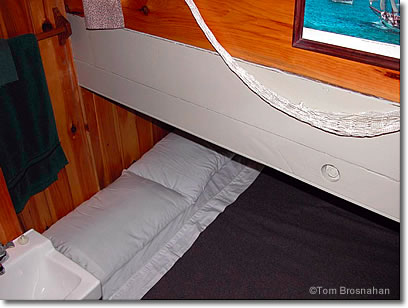
Tidy—but tiny! A cabin aboard Maine windjammer American Eagle. The photo was taken from outside the cabin, looking in. Just enough room for the bed, the sink, and a small hammock for belongings. And this is for two voyagers!
How to Pack
Pack your clothes in soft-sided luggage (duffle bag, knapsack) the easier to fit your stuff and luggage into the odd cubbies and under-bunk spaces on a wooden vessel. You probably won't find room for a hard-sided suitcase or wheelie bag.
Other items you may want: camera, binoculars, small games you like (cards, cribbage, etc.), tablet computer, books. If you play a musical instrument, that may be welcome on board as well.
Mobile Phones
Mobile phones can often find a signal from a nearby shore town while you're cruising, but you can't depend on always placing or receiving calls. Check with your vessel to learn what electrical charging may be available on board. As for Wifi and Internet, you depend on your phone for access.
Life Aboard a Maine Windjammer
What comes to mind when you hear "Maine windjammer cruise"? A large, elegant, commodious vessel with ample staff and all the comforts?
Think again!
A Maine windjammer sloop or schooner is just the opposite of your typical cruise ship:
Wind Power!
Main motive power is by sail, with an auxiliary engine or yawl boat for calm days. The wind really does move you along, and if there's no wind you go slow, or anchor until the wind rises.
Economy of Space
By shore or cruise ship standards, all spaces on board are small. The cabins, the common areas, the galley (kitchen), the heads (toilets)—there is just enough room for every function, with no space wasted. When you first come aboard, you may feel a bit of claustrophobia, but after a few hours you'll get used to it and wonder "why did I think I needed more space?" You'll come to admire the economy and ingenuity of a trim vessel's design and construction.
Electricity, Phones, Wifi
Some of the larger windjammers have standard 120-volt, 60 Hz electrical current powered by a generator at certain times during the day. Most also have a low-voltage system to power low-wattage lights, ship-to-shore radios and navigational instruments, and most provide power at least to charge small electronics, but you may not be able to plug in a high-wattage appliance such as a hair dryer.
Check with the individual vessel of your choice for specifics.
Phone signals vary depending on location and distance from shore—you won't be able to connect at all times. There is no Wifi aboard, though you may be able to connect via your phone.
Noise & Quiet
If you make a noise—any noise—someone else, perhaps everyone else, will hear it. When under sail, a blissful quiet reigns, with only the occasional creak of a line, luff of a sail, patter of rain on deck, or the gentle ripple of water along the sides. When maneuvering, the thrum of a diesel engine in the vessel or in the separate yawl boat may cover other sounds, but normally the diesel doesn't run much.
Plan to use your electronic devices with headphones, not speakers, so as to preserve this wonderful ambiance.
Sinks, Toilets & Showers
Most windjammer cabins have a sink with cold (and also, on some vessels, hot) running water. Heads (toilets) are usually on the corridor and shared, though more expensive cabins and suites may have their own. Many vessels have shared hot and cold showers.
You Are Auxiliary Crew!
The crew takes care of most shipboard tasks, but voyagers may be asked to help hoist, lower and furl the sails and other simple tasks requiring many hands. There are usually plenty of hands, and you needn't help if you don't care to. Depending on the vessel and sailing conditions, you may be permitted to try other tasks if you like: swabbing the decks, polishing brasswork, even taking the helm and playing captain for awhile.
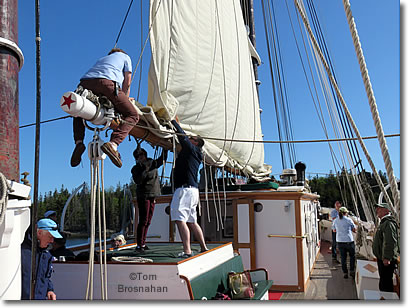
Passengers help furl the mainsail on Windjammer Victory Chimes.
(The person seated on the boom is a crew member.)
Free Time
Except for mealtimes when everyone comes together, your time is your own. Read, chat, nap, play games, shoot photos, look for birds.... If your vessel offers themed cruises—music, yoga, cooking lessons, wine tastings, etc.—you may participate or not, as you wish. A windjammer voyage is active at times, passive at times, social when you want it, solitary when you need it, as you choose.
Meals & Shore Dinners
Meals are prepared onboard in the galley, and include non-alcoholic beverages. (Some cruises may include wine or beer at dinner, or you may bring your own beverages.) Dinner on the first night, when you board the vessel, is usually NOT included, but breakfast on the last morning, before you debark, is included.
Meals are prepared fresh onboard. If you have special dietary needs—vegan, vegetarian, allergies or intolerances—be sure to advise the vessel in advance so the chef can lay in the necessary supplies before departure.
Most cruises include a lobster dinner. Crew and voyagers may tender to an island beach, spread out appetizers and salads, then boil up a few dozen lobsters. Sit on the beach, the rocks or a piece of driftwood, pull your lobster apart with your hands and enjoy!
(All litter—including the lobster shells—goes back to your vessel for proper disposal.)
Weather or other considerations may make it necessary to dine on the vessel rather than on shore.
Smoking
No smoking is allowed belowdecks. Smoking on deck, in the open air, may be allowed. Check your vessel's rules in advance. If smoking on deck is allowed, be considerate and do it downwind from others.
Parking & Tips
If you drive to your port of embarcation you will need to park your car for the duration of the voyage. Windjammers provide parking, sometimes free, other times for a fee of $15 to $25 per night or per cruise, depending on the vessel.
As for tips, it's traditional to tip the crew 10% of your cruise fee, or about $15 per day. It's supposedly up to you, but most people see it as an obligation.
Maine Windjammer Ports
The historic sailing ships that cruise along the thousands of miles of Maine coastline, dodging among its hundreds of islands big and small, have their home ports in only a few cities.
Mid-coast Maine, and particularly Penobscot Bay, are prime areas for cruising because of their natural beauty, variety of scenes, and abundant harbors, coves and mooring places.
Portland
Not just Maine's largest city, but an important port as well for all sorts of vessels, including Maine windjammers. More...
Camden
The lovely town of poet Edna St-Vincent Millay has a harbor crowded with fine Maine windjammers ready to sail among the islands of Penobscot Bay. Good choice! More...
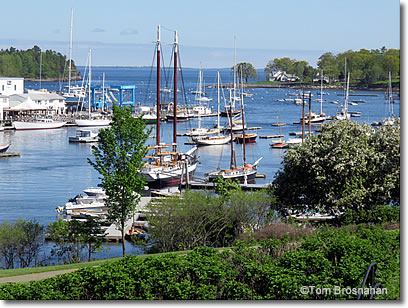
Windjammers and other sailing craft in Camden harbor,
ready for the next voyage.
Rockland
With one of Maine's best harbors and many experienced captains, Rockland, southwest of Camden, is well placed for Maine windjammer cruises, with many of the best vessels and all of Penobscot Bay waiting for them. More...
Bar Harbor
Known mainly for Acadia National Park, Bar Harbor is also an active Maine windjammer port. More...
Windjammer Gam
Gam was the 19th-century whalers' term for a gathering of whales. The term carried over to a gathering of ships: when two or more whaling ships encountered one another during their long voyages, it was customary to anchor and tie up together so the crews could socialize.
The custom survives among Maine windjammers to this day. Early in the sailing season (usually June), most or all of the windjammers described above will meet at an anchorage in Penobscot Bay for a gam: they tie together, serve grog, set up a band, and have a party on the water.
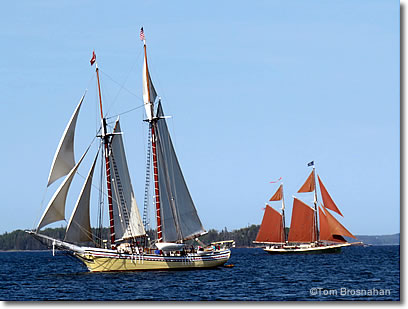
Two windjammers under full sail arrive at the anchorage,
ready to tie up for a gam.
As many as eight windjamming schooners of the Maine Windjammer Association meet, anchor and tie together on a particular date early in the summer cruising season, although it's not just the crews that socialize.
Passenger-voyagers on each vessel can walk to all the other vessels, visit the boats, passengers and crew, and enjoy society on the sea.
Voyagers on any of the windjammers can climb to the others for a look around, a chat, and an evening's enjoyment.
Check the individual windjammers' summer cruising programs to see when the gam will occur. It's a real treat!
List of Maine Windjammers
You love the spectacular Maine coast, and the sea, and the idea of sailing along the coast and among the islands for a few days, with the scent of the sea, the breeze filling the sails, the quiet rush of water as your vessel makes way.
You want to go to bed and be gently rocked to sleep by the sea, and wake to a morning misty or bright, but always delightful.
You enjoy the society of other voyagers, the home-style meals cooked on a galley stove, the afternoons on deck or relaxing in your cabin, the evenings sharing the day's observations with your mates. If there are special programs—music, yoga, nature lore—you can participate or not, as you wish.
But which Maine windjammer to choose?
Here's a list of some of the finest boats, all members of the Maine Windjammers Association:
American Eagle
Captain John Foss skippers 3- to 11-day cruises along the coast, as far north as Campobello Island, and south to Gloucester, Massachusetts, for up to 26 passengers on this 92-foot historic vessel.
Angelique
Captain Dennis Gallant & Candace Kuchinski offer 3-, 4-, 5- and 6-night cruises, some with special themes, from Memorial Day to early October on the 130-foot vessel built to a traditional English design in 1980. Seven crew care for the ship and its 29 passengers in 15 cabins.
Heritage
Captains Doug & Linda Lee skipper the 95-foot-long Heritage built in 1983 to a traditional Maine schooner design. The 16 cabins accommodate 30 passengers.
Ladona
Captain J.R. Braugh will take you on 3- to 7-night cruises June through October. Built in 1922 as a private yacht, renovated in 1971 and again just a few years ago, Ladona has had an eventful history, and now provides a variety of high-comfort cruises for 17 passengersin nine cabins.
Lewis R. French
Captains Garth Wells and Jenny Tobin pilot this historic 65-foot Maine schooner launched in Christmas Cove in 1871. The French carried cargo along the coast for a century, then was rebuilt for passengers in 1971. Her 13 cabins include five singles for which no single supplement is charged.
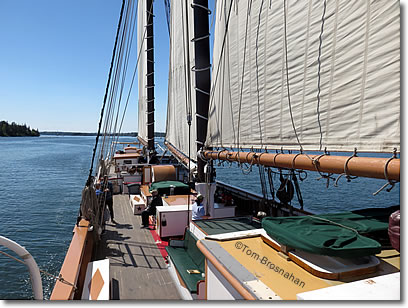
Adventure aboard a windjammer!
Mary Day
Captains Barry King & Jennifer Martin boast that the Mary Day is "the first schooner built for passenger comfort," with 14 cabins including two singles and two triples, nine feet of headroom in most, plus windows and skylights that open for air and light.
Stephen Taber
Captain Noah & Jane Barnes command the Taber, launched in 1871 and claimed to be the oldest documented sailing vessel in continuous service in the USA—a National Historic Landmark. Rebuilt in the early 1980s, she has 12 cabins for 22 voyagers: 6 with twin beds, 4 with doubles, and two singles. The captains pride themselves on the quality of their cuisine and wines.
Victory Chimes
Captain Sam Sikkema commands this 127.5-foot long, 23.8-foot wide former freighter launched in 1900. Converted to passenger service in 1946 and extensively renovated in 1988, this largest of Maine windjammers accommodates up to 40 passengers in 22 cabins and suites that are the most spacious among the fleet. More...
Windjammer Organizations
Windjammers may be independently owned and marketed, or part of a group of windjammers that unite for marketing and quality control.
The two major organizations are Maine Windjammer Cruises and Downeast Maine Cruises. There's also Eastport Windjammers out of way-Down East Eastport, Maine, on the Canadian border.
Five Maine windjammers of the Maine Windjammers Association have been designated as National Historic Landmarks by the US National Park Service.
